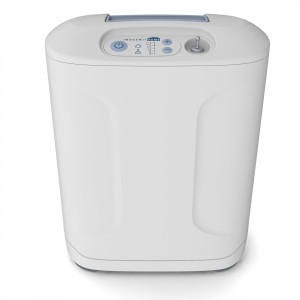Home oxygen safety is one of the most important aspects of oxygen therapy, whether you choose an oxygen concentrator, oxygen cylinders or a liquid oxygen system as your oxygen supply source. Although oxygen is a safe, non-flammable gas, it does support combustion,[1] meaning things burn more readily and ignite easier in its presence.[2] As such, you must be careful to follow oxygen safety in the home, and to make sure anyone in your home is aware of oxygen tank safety. Here are some oxygen precautions you should take to ensure that you are following the home oxygen safety guidelines.


Keep oxygen canisters at least 6-10 feet away from any heat source, including gas stoves, lit fireplaces, wood burning stoves, candles, lighters or other types of open flame. Oxygen tank safety relies on keeping your oxygen away from flames.[1]
Store oxygen canisters safely and securely in the upright position, away from any type of heat source and in an approved oxygen storage cart or other device designed to store home oxygen with oxygen tank safety in mind.[1]
Support home oxygen safety and reduce the risk of home fires by turning your oxygen supply valve to the off position when oxygen is not in use.[1]
Maintain a minimum distance of 8 feet from heat-producing devices, anything that may cause a spark around home oxygen, including electric heaters, electric blankets, electric razors, hair dryers, electric appliances or friction toys.[3]
Install and maintain smoke detectors in your home. Replace batteries regularly. Perform weekly checks. Keep a fire extinguisher on hand and know how to use it.[1] Plan and practice an emergency evacuation route for you and your family to use in the event of a fire.[2]
Familiarize yourself with your oxygen equipment and the safety checks established by your home oxygen supply company. If you do not understand how something works, ask for more information and a demonstration.
Inform your power company that you are oxygen dependent. Many companies offer oxygen-dependent patients priority service or even a generator when their power goes out. Find out what steps you need to take to get this type of service and improve your oxygen safety in the home.[1]
Though oxygen itself is not flammable, it does create an environment in which fires are more likely.[1] Accordingly, it is essential that you follow fire safety rules and oxygen tank safety whenever you are around an oxygen source or you or someone else is receiving oxygen therapy. Follow these oxygen safety tips to help you take better oxygen precautions. It is always better to play it safe when it comes to oxygen safety in the home.
Oxygen is quite safe when used properly and oxygen precautions are followed. The 10 home oxygen safety guidelines listed above will help ensure that you know how to use oxygen therapy safety to keep you and your household out of harm’s way. Just remember never to smoke or use an open flame near oxygen, and always follow your doctor’s instructions for use to ensure that you are getting the right amount of oxygen for you. Using your supplemental oxygen incorrectly or too frequently or infrequently could put you and your health in danger,[3] so make sure that your oxygen supplier shows you how to use your oxygen equipment properly. Oxygen safety in the home is easy to achieve as long as you follow the oxygen precautions.
Oxygen tank safety is slightly different than precautions for oxygen concentrators. Oxygen tank safety requires that oxygen tanks be kept upright at all times to protect against falls, which could cause a leak in the valve, hoses or connections on the tank. Additionally, you have to be sure that you are opening and closing the valves properly any time you use your oxygen tank to ensure that it is not leaking.[4] As with any oxygen source, never smoke near your oxygen tank and keep it away from open flames and heat sources.
Keep in mind that, when used properly, oxygen tanks are quite safe and oxygen tank safety is easy to achieve. However, when used incorrectly or when accidents occur, an oxygen tank can explode. The main causes of fires and explosion when using oxygen are: oxygen enrichment from leaking equipment, use of materials not compatible with oxygen, use of oxygen in equipment not designed for oxygen service, and incorrect or careless operation of oxygen equipment.[4] Just follow oxygen safety in the home and on the go and be vigilant about using your tank properly, keeping it away from flame or heat and checking for leaks.
By Deborah Leader RN, BSN, PHN